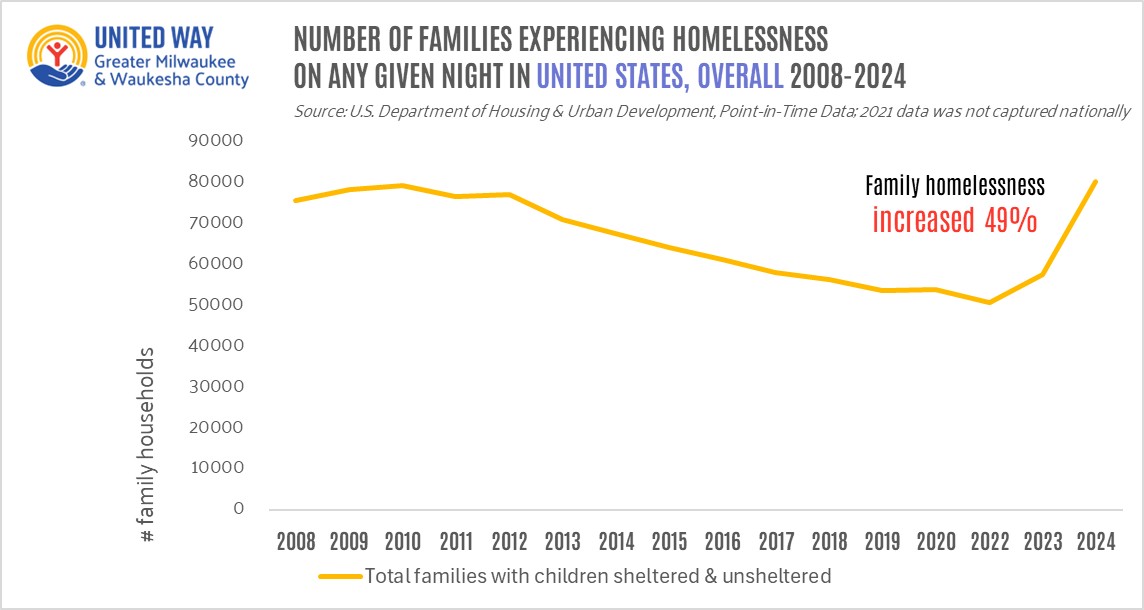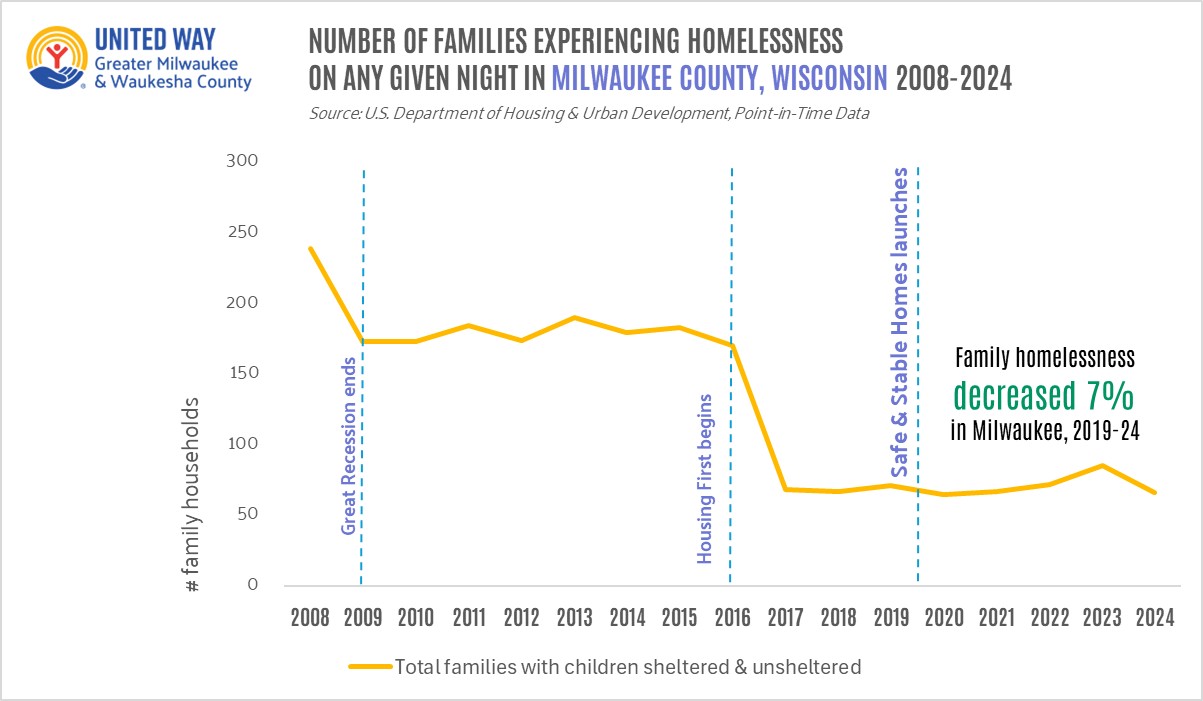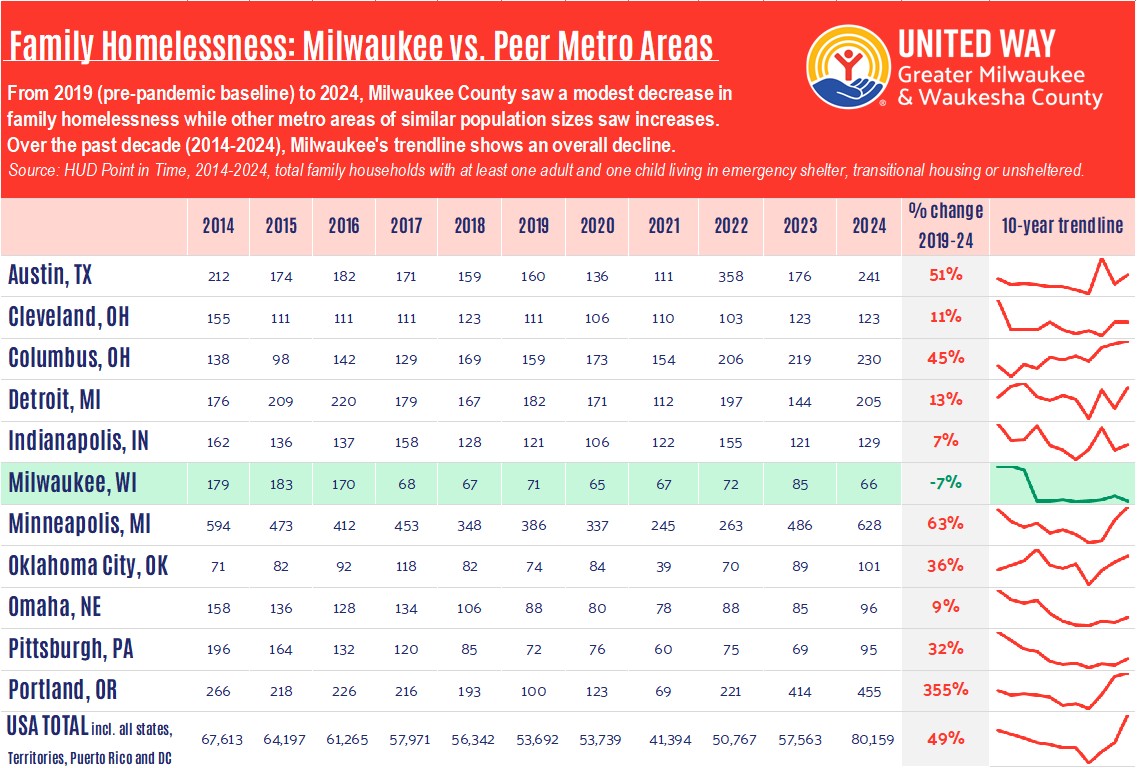Family Homelessness Decreases After Five Years of Targeted Investments

August 25, 2025
By Krystina Kohler, Impact Manager, Safe & Stable Homes
In July 2020, United Way of Greater Milwaukee & Waukesha County launched its first investments in Safe & Stable Homes: Ending Family Homelessness, a key initiative to end family homelessness in our four-county footprint. The goal was ambitious: to meet the official definition of “ending family homelessness” established by the U.S. Interagency Council on Homelessness – preventing homelessness whenever possible, and when it can’t be prevented, ensuring it is a rare, brief, and one-time experience.
Five years later, the results are clear: Milwaukee County is one of the few communities in the nation to see a decline in family homelessness.
Nationally, homelessness is at record highs. On any given night in 2024, more people experienced homelessness in the United States than in any other time since the U.S. Department of Housing & Urban Development (HUD) started capturing this data in 2005. This record high holds true for all subpopulations except for veterans.i Families saw their largest year-over-year increase between 2023-24.ii
Chart 1 (below) shows that from 2019 (as a pre-Safe & Stable Homes baseline) to 2024, the number of families experiencing homelessness on any given night increased by 49% nationwide.iii This surge is largely due to post-pandemic challenges, including rising rents, a shortage of affordable housing, and the end of temporary COVID-era protections.

But Milwaukee’s results tell a different story. While the rest of the nation experienced sharp increases, Milwaukee moved in the opposite direction. From 2019 to 2024, the number of families experiencing homelessness decreased by 7% in Milwaukee County.

Chart 2 (above) highlights a decade and a half of change. After years of steady numbers, 2016 marked a turning point with the start of Housing First strategies. The launch of Safe & Stable Homes in 2019 strengthened this momentum, helping to stabilize families before a housing crisis escalated into homelessness.
This wasn’t luck. It was the result of targeted strategies:
- Early intervention: Identifying housing instability before a family loses their home.
- Flexible funding: Removing financial barriers quickly to keep families housed.
- Prevention & diversion: Embedding eviction prevention resources across sectors like education, animal welfare, and the legal system to identify and support families in need.
- Collaborative partnerships: Service providers, government, and philanthropy working toward a shared goal.
The difference becomes even clearer when Milwaukee is compared to metro areas of similar size.

Chart 3 (above) shows changes in family homelessness across ten peer communities.iv While nearly every other metro saw significant increases – in some cases more than 50% – Milwaukee’s numbers declined by 7%.
Looking further back over the past ten years (2014-24), Milwaukee is one of the only communities with a consistent downward trajectory. This progress is the direct result of coordinated response systems, cross-sector partnerships, and a community focused on prevention and housing as the solution to homelessness.
Milwaukee’s experience proves that rising national trends don’t have to be inevitable. With early intervention, flexible funding, and strong collaboration, communities can reverse the trajectory of family homelessness.
But this progress is fragile. Continued investment in eviction prevention and housing programs will be critical to maintaining and expanding these gains, especially as housing costs remain high and affordable units remain scarce.
The success of Safe & Stable Homes belongs to our entire community: service providers, funders, policymakers, and advocates who believe every family deserves a safe, stable home.
We’ve seen what’s possible. We know what works to end homelessness. Now is the time to keep pushing until rare, brief, and one-time becomes the reality for every family facing housing instability in Greater Milwaukee & Waukesha County.v
We invite you to continue being part of this lasting change by supporting United Way’s Safe & Stable Homes initiative during our 2025 Community Campaign. Because United is the Way we end family homelessness.
i The federal government has made targeted, sustained investment into housing programs for military veterans through the HUD-VASH program since 1992. For analysis of its effectiveness, see Evans WN, et al. Housing and Urban Development-Veterans Affairs Supportive Housing Vouchers and Veterans' Homelessness, 2007-2017. Am J Public Health. 2019 Oct;109(10):1440-1445. Other “subpopulations” experiencing record high homeless rates in 2024 include single adults, chronically homeless individuals, unsheltered and sheltered individuals, and unaccompanied youth.
ii The 2024 Annual Homelessness Assessment Report (AHAR) to Congress, The U.S. Department of Housing and Urban Development Office of Community Planning and Development, December 2024. Accessible here: https://www.huduser.gov/portal/sites/default/files/pdf/2024-AHAR-Part-1.pdf.
iii 2024 is HUD’s most recent published Point-in-Time data as of August 18, 2025.
iv Peer metro areas were chosen based off Continuum of Care networks representing approximately 1 million inhabitants.
v United Way’s Safe & Stable Homes initiative reaches a four-county community: Milwaukee, Waukesha, Ozaukee, and Germantown within Washington county. HUD Point-in-Time numbers used for this analysis report on “Continuums of Care” or CoCs. Wisconsin has four CoCs: Milwaukee County, Dane County, Racine County, and the Balance of State which includes all remaining counties in Wisconsin. Since Ozaukee, Waukesha, and Washington county Point-in-Time data is not disaggregated from the WI Balance of State total, we only reported on Milwaukee data here.
Interested in supporting Safe & Stable Homes?
Click here to donate.
For more updates on Safe & Stable Homes and other United Way initiatives, follow us on Facebook, Instagram, and LinkedIn.
